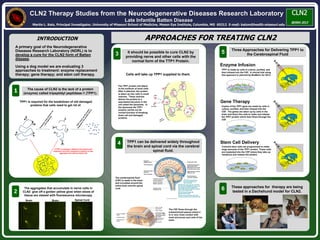Report
Share
Download to read offline

Recommended
More Related Content
What's hot
What's hot (19)
STEM CELL THERAPY HAS A PROMISE IN PARKINSON’S DISEASE , Dr. Sharda Jain 

STEM CELL THERAPY HAS A PROMISE IN PARKINSON’S DISEASE , Dr. Sharda Jain
Long-lasting alterations to DNA methylation and ncRNAs could underlie the eff...

Long-lasting alterations to DNA methylation and ncRNAs could underlie the eff...
Pten and eph b4 regulate the establishment of perisomatic inhibition in mouse...

Pten and eph b4 regulate the establishment of perisomatic inhibition in mouse...
Viewers also liked
A New and Effective Target for Infantile Batten Disease2016 BDSRA Shyng, Nelvagal, Dearborn, Cooper, Sands CLN1

2016 BDSRA Shyng, Nelvagal, Dearborn, Cooper, Sands CLN1Batten Disease Support and Research Association
Viewers also liked (8)
2016 BDSRA Cooper CLN1, CLN2, CLN3, CLN5, CLN6, CLN7

2016 BDSRA Cooper CLN1, CLN2, CLN3, CLN5, CLN6, CLN7
2016 BDSRA Shyng, Nelvagal, Dearborn, Cooper, Sands CLN1

2016 BDSRA Shyng, Nelvagal, Dearborn, Cooper, Sands CLN1
Similar to Lincl katz
Similar to Lincl katz (20)
Faithful cell division requires tightly controlled protein placement

Faithful cell division requires tightly controlled protein placement
Schizophrenia Research Forum Live Webinar - June 28, 2017 - Rusty Gage 

Schizophrenia Research Forum Live Webinar - June 28, 2017 - Rusty Gage
Endothelial Cell Mediated Delay of Blood Brain Barrier Recovery Following Tra...

Endothelial Cell Mediated Delay of Blood Brain Barrier Recovery Following Tra...
Analysis of Human Embryonic Stem Cells with Regulatable Expression of the Cel...

Analysis of Human Embryonic Stem Cells with Regulatable Expression of the Cel...
More from Batten Disease Support and Research Association
Sheep as models for Batten disease - update on current Australian research2017 BDSRA Tammen, Grupen, James and Delerue CLN6 CLN7

2017 BDSRA Tammen, Grupen, James and Delerue CLN6 CLN7Batten Disease Support and Research Association
Rustic global and widespread local white matter abnormalities in juvenile neuronal ceroid lipofuscinosis2017 BDSRA Autti, U. Roine, T. Roine, Aberg, Tokola, Balk, Hakkarainen, Manne...

2017 BDSRA Autti, U. Roine, T. Roine, Aberg, Tokola, Balk, Hakkarainen, Manne...Batten Disease Support and Research Association
Developing New Therapies for Batten Disease: Patient Involvement2017 BDSRA Mole, Band, Codd and West CLN3, CLN6, CLN7

2017 BDSRA Mole, Band, Codd and West CLN3, CLN6, CLN7Batten Disease Support and Research Association
Testing therapies for CLN5 and CLN62017 BDSRA Hughes, Best, Wicky, Clare, Cheong, Yip, Biggs and Mace CLN5 CLN6

2017 BDSRA Hughes, Best, Wicky, Clare, Cheong, Yip, Biggs and Mace CLN5 CLN6Batten Disease Support and Research Association
More from Batten Disease Support and Research Association (20)
2017 BDSRA Tammen, Grupen, James and Delerue CLN6 CLN7

2017 BDSRA Tammen, Grupen, James and Delerue CLN6 CLN7
2017 BDSRA Autti, U. Roine, T. Roine, Aberg, Tokola, Balk, Hakkarainen, Manne...

2017 BDSRA Autti, U. Roine, T. Roine, Aberg, Tokola, Balk, Hakkarainen, Manne...
2017 BDSRA Trometer, Potier, Cournoyer, and Schermer

2017 BDSRA Trometer, Potier, Cournoyer, and Schermer
2017 BDSRA Mole, Band, Codd and West CLN3, CLN6, CLN7

2017 BDSRA Mole, Band, Codd and West CLN3, CLN6, CLN7
2017 BDSRA Hughes, Best, Wicky, Clare, Cheong, Yip, Biggs and Mace CLN5 CLN6

2017 BDSRA Hughes, Best, Wicky, Clare, Cheong, Yip, Biggs and Mace CLN5 CLN6
Lincl katz
- 1. Late Infantile Batten Disease Martin L. Katz, Principal Investigator, University of Missouri School of Medicine, Mason Eye Institute, Columbia, MO 65212 E-mail: katzm@health.missouri.edu 1 APPROACHES FOR TREATING CLN2 CLN2 Therapy Studies from the Neurodegenerative Diseases Research Laboratory The cause of CLN2 is the lack of a protein (enzyme) called tripeptidyl peptidase-1 (TPP1). TPP1 is required for the breakdown of old damaged proteins that cells need to get rid of. If TPP1 is missing or defective the proteins and fragments cannot be chopped up properly so they aggregate and build up inside cells 2 The aggregates that accumulate in nerve cells in CLN2 give off a golden yellow glow when slices of tissue are viewed with fluorescence microscopy. Brain Brain Spinal Cord 5It should be possible to cure CLN2 by providing nerve and other cells with the normal form of the TTP1 Protein. Cells will take up TPP1 supplied to them. The TPP1 protein will attach to the surfaces of most cells. After it attaches, the protein is taken up into cells in small vesicles. These vesicles deliver the protein to a specialized structure in the cell called the lysosome. In the lysosome the TPP1 enzyme carries out its normal function of breaking down old and damaged proteins. 3 4 TPP1 can be delivered widely throughout the brain and spinal cord via the cerebral spinal fluid. Three Approaches for Delivering TPP1 to the Cerebrospinal Fluid 6 Enzyme Infusion Gene Therapy Stem Cell Delivery These approaches for therapy are being tested in a Dachshund model for CLN2. TPP1 is made by cells in culture, purified, and then infused into the CSF. A clinical trial using this approach is planned by BioMarin for 2013. Copies of the TPP1 gene are made by cells in culture, purified, and then infused into the CSF. The genes are taken up by cells in the brain and direct the cells to make and release the TPP1 protein which then flows through the CSF. Cultured stem cells are programmed to make large amounts of the TPP1 protein. These cells are implanted into the CSF where they take up residence and release the protein. INTRODUCTION A primary goal of the Neurodegenerative Diseases Research Laboratory (NDRL) is to develop a cure for the CLN2 form of Batten disease. Using a dog model we are evaluating 3 approaches to treatment: enzyme replacement therapy; gene therapy; and stem cell therapy. The cerebrospinal fluid (CSF) is made in the brain and circulates around the entire brain and the spinal cord. The CSF flows through the subarachnoid spaces where it is in very close contact with most structures and cells of the brain.
